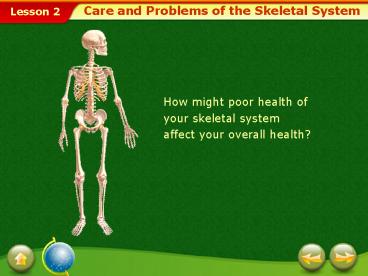Care and Problems of the Skeletal System - PowerPoint PPT Presentation
1 / 22
Title: Care and Problems of the Skeletal System
1
Care and Problems of the Skeletal System
How might poor health of your skeletal system
affect your overall health?
2
Care and Problems of the Skeletal System
If your skeletal system cannot perform its
functions properly, your freedom of movement may
be limited and other areas of your health and
lifestyle may also be affected.
3
Lesson Objectives
In this lesson, youll learn to
- Examine strategies to prevent injuries that
damage the skeletal system. - Analyze the relationship between health promotion
and prevention of bone disorders. - Identify different types of joint injuries and
situations requiring professional health services.
4
Care of the Skeletal System
Tips for Healthy Bones and Joints
5
Problems of the Skeletal System
- Fractures
- Fractures can be either compound or simple.
- A compound fracture is one in which the broken
end of thebone protrudes through the skin. - A simple fracture is one in which the broken bone
does not protrude.
6
Problems of the Skeletal System
Classification of Fractures
- Hairline fracture The fracture is incomplete,
and the two parts of the bone do not separate. - Transverse fracture The fracture is completely
across the bone. - Comminuted fracture The bone shatters into more
than two pieces, usually as a result of severe
force.
7
Problems of the Skeletal System
- Osteoporosis
- Osteoporosis makes bones weak and brittle.
- Regular physical activity stimulates bone cells
to increase bone mass, thereby reducing the risk
of osteoporosis. - Early detection is essential to treatment and to
slowing loss of bone tissue.
8
Problems of the Skeletal System
- Scoliosis
- Scoliosis may exist at the time of birth, or it
can develop during childhood. - The curvature of the spine worsens as growth
continues and may proceed even after growth
stops. - Treatment includes wearing a brace to help
straighten the spine and, in more severe cases,
surgery.
9
Problems of the Skeletal System
- Typical Joint Injuries
10
Problems of the Skeletal System
Dislocation
- Dislocation results when the ligaments that
attach the boneat the joint are torn as the bone
slips out of place. - Never attempt to replace a dislocated joint get
immediate medical help. - Treatment includes having the joint reset and
immobilizedwhile the ligaments heal.
11
Problems of the Skeletal System
Torn Cartilage
- Torn cartilage can result from a sharp blow or
the twisting of a joint. - Injuries are treated with arthroscopic surgery.
12
Problems of the Skeletal System
Bursitis
- Bursitis results from the inflammation of a
fluid-filled sac called the bursa. - Certain joints have bursae that help reduce
friction between their movable parts. - When the bursa becomes inflamed, pain and
swelling can occur at the joint.
13
Problems of the Skeletal System
Bunion
- A bunion is a painful swelling of the bursa in
the first joint of the big toe. - Large bunions may require surgery.
14
Problems of the Skeletal System
Arthritis
- Arthritis is the inflammation of a joint.
- The condition can result from an injury, natural
wear and tear, or autoimmune disease.
15
Problems of the Skeletal System
Repetitive Motion Injury
- One of the most common repetitive motion injuries
is carpal tunnel syndrome. - This condition occurs when swollen ligaments and
tendons in the wrist cause numbness, a burning or
tingling sensation in the thumb and forefinger,
pain, and weakness in the hand. - Treatment includes wearing a splint to reduce
wrist movements, medication to reduce swelling
and, in a small percentage of cases, surgery.
16
Quick Review
Provide a short answer to the question given
below.
Q. Name three behaviors that help keep your bones
and joints healthy.
Click Next to view the answer.
17
Quick Review - Answer
- A. Three behaviors that help keep your bones and
joints healthy are - Eating foods that contain calcium, vitamin D, and
phosphorus - Getting regular physical activity
- Wearing protective gear when you participate in
sports
Click Next to attempt another question.
18
Quick Review
Provide a short answer to the question given
below.
Q. What should you do if you think someone has a
fractured bone or dislocated joint?
Click Next to view the answer.
19
Quick Review - Answer
A. If someone has a fractured bone or dislocated
joint, you should get medical help immediately.
Click Next to attempt another question.
20
Quick Review
Provide a short answer to the question given
below.
Q. Explain how to prevent repetitive motion
injury.
Click Next to view the answer.
21
Quick Review - Answer
A. To prevent repetitive motion injury, you
should take frequent breaks, adjust chair height,
and use special equipment.
Click Next to attempt another question.
22
Quick Review
Provide a suitable analysis.
Analyze the relationship between health promotion
during your teen years and the prevention of
osteoporosis later in life.





























